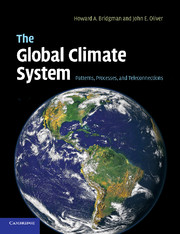Book contents
- Frontmatter
- Contents
- List of contributors
- Preface
- List of abbreviations
- 1 Introduction
- 2 Oscillations and teleconnections
- 3 Tropical climates
- 4 Middle-latitude climates
- 5 Climate of the polar realms
- 6 Post-glacial climatic change and variability
- 7 Urban impacts on climate
- 8 Human response to climate change
- 9 ESSAY: Model interpretation of climate signals: an application to Asian monsoon climate (Lau)
- 10 Conclusions and the future of climate research
- Other books on climatology and the climate system
- Index
- Plate section
- References
3 - Tropical climates
Published online by Cambridge University Press: 05 June 2012
- Frontmatter
- Contents
- List of contributors
- Preface
- List of abbreviations
- 1 Introduction
- 2 Oscillations and teleconnections
- 3 Tropical climates
- 4 Middle-latitude climates
- 5 Climate of the polar realms
- 6 Post-glacial climatic change and variability
- 7 Urban impacts on climate
- 8 Human response to climate change
- 9 ESSAY: Model interpretation of climate signals: an application to Asian monsoon climate (Lau)
- 10 Conclusions and the future of climate research
- Other books on climatology and the climate system
- Index
- Plate section
- References
Summary
Introduction
For many years, from early exploration to perhaps the middle of the twentieth century, the weather and climate of the tropical world were considered among the most easily explained of all world climate systems. The daily rainfall of the equatorial zone, the constancy of the trade winds, and the unrelenting aridity of the tropical deserts gave an impression of benign and unchanging conditions. Such is far from the case. Within the tropics are some of the most interesting and difficult to explain phenomena of the world's climates.
The Earth's tropical regions are, in terms of geographic location, the area between the Tropic of Cancer (23.5° N), and the Tropic of Capricorn (23.5° S). Such a definition is not suitable, however, for identification of the climatic regimes and over the years a number definitions have been suggested. In his classification of world climate in 1896, Supan proposed that locations with annual average temperature greater than 20°C might be considered as the tropics. In his widely used 1918 classification, Köppen classed tropical climates as having the average temperature of each month greater than 18°C. Using this criterion, the wet tropical climates occupy some 36% of the Earth's surface. If the tropical deserts are added to this class, then the tropics comprise almost 50% of the surface area of the world.
- Type
- Chapter
- Information
- The Global Climate SystemPatterns, Processes, and Teleconnections, pp. 59 - 95Publisher: Cambridge University PressPrint publication year: 2006



